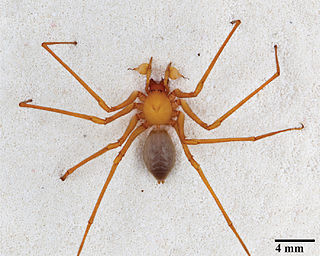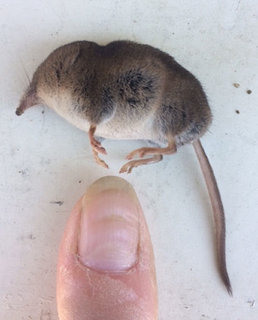
The micrometre or micrometer, also commonly known as a micron, is an SI derived unit of length equalling 1×10−6 metre ; that is, one millionth of a metre.

The crankset or chainset, is the component of a bicycle drivetrain that converts the reciprocating motion of the rider's legs into rotational motion used to drive the chain or belt, which in turn drives the rear wheel. It consists of one or more sprockets, also called chainrings or chainwheels attached to the cranks, arms, or crankarms to which the pedals attach. It is connected to the rider by the pedals, to the bicycle frame by the bottom bracket, and to the rear sprocket, cassette or freewheel via the chain.

Atypidae, also known as atypical tarantulas or purseweb spiders, is a spider family containing only three genera. They are accomplished ambush predators that spend most of their time in a sock-like, silken retreat on the ground from where they kill their prey.

The spider species Araneus diadematus is commonly called the European garden spider, diadem spider, orangie, cross spider and crowned orb weaver. It is sometimes called the pumpkin spider, although this name is also used for a different species, Araneus marmoreus. It is an orb-weaver spider found in Europe and North America.

Chlorophytum comosum, often called spider plant but also known as airplane plant, St. Bernard's lily, spider ivy, ribbon plant, and hen and chickens is a species of perennial flowering plant. It is native to tropical and southern Africa, but has become naturalized in other parts of the world, including western Australia. Chlorophytum comosum is easy to grow as a houseplant; variegated forms are the most popular.

Phidippus audax is a common jumping spider of North America. It is commonly referred to as the daring jumping spider, or bold jumping spider. The spider belongs to the genus Phidippus, a group of jumping spiders easily identified both by their relatively large size and their iridescent chelicerae.

Naphrys is a genus of North American jumping spiders that was first described by Glavis Bernard Edwards in 2003. The name is a portmanteau of "North America" and "Euophrys".

Periegops is a genus of spiders with six eyes instead of the usual eight. It is the only genus in its family (Periegopidae) and has three described species. It was long considered to be members of Sicariidae or Segestriidae until Raymond Forster elevated them to the family level in 1995.

Stenochilidae is a family of southeast Asian araneomorph spiders that produce ecribellate silk. First described by Tamerlan Thorell in 1873, it now contains twelve described species in two genera.

The Kauaʻi cave wolf spider, also known to local residents as the "blind spider", is only known to occur in a few caves in a lava flow with an area of 10.5 km2 (4.1 sq mi) in the Kōloa–Poʻipū region of Kauaʻi, Hawaiian Islands, and only six populations are known to exist. While their nearest surface-dwelling relatives have large eyes, this species has completely lost its eyes. They reach a body length around 20 mm (0.8 in), and are reddish brown and completely harmless to people. Unlike most wolf spiders, it produces only 15 to 30 eggs per clutch. The female carries the egg sac in her mouthparts until the spiderlings hatch.

Tasmannia xerophila, commonly known as alpine pepperbush, is a shrub of eucalypt forest, alpine grassland and rocky terrain of New South Wales and Victoria, Australia.

Arachnura higginsi, known as the tailed spider or scorpion tailed spider and the scorpion orb weaver, is a common Australian spider belonging to the family Araneidae. It occurs in many parts of Australia.

Zygoballus sexpunctatus is a species of jumping spider which occurs in the southeastern United States where it can be found in a variety of grassy habitats. Adult spiders measure between 3 and 4.5 mm in length. The cephalothorax and abdomen are bronze to black in color, with reddish brown or yellowish legs. The male has distinctive enlarged chelicerae and front femora. Like many jumping spiders, Z. sexpunctatus males exhibit ritualized courtship and agonistic behavior.

Trogloraptor is a genus of large spiders found in the caves of southwestern Oregon. It is the sole genus in the family Trogloraptoridae, and includes only one species, Trogloraptor marchingtoni. These spiders are predominantly yellow-brown in color with a maximum leg span of 3 in (7.6 cm). They are remarkable for having hook-like claws on the raptorial last segments of their legs.
Pinkfloydia is a genus of small Australian long-jawed orb-weavers, reaching a maximum lengths of about 4.5 millimetres (0.18 in). It was first described by D. Dimitrov & G. Hormiga in 2011, and contains two species, found in New South Wales and Western Australia: P. harveyi and P. rixi. They have a unique rounded, cone-shaped head structure with one pair of large eyes and three pairs of smaller eyes. The genus is named after British rock band Pink Floyd.

The long-tailed shrew or rock shrew is a small North American shrew found in Atlantic Canada and the Northeastern United States.
Melaleuca xerophila is a shrub or small tree in the myrtle family Myrtaceae and is native to arid parts of South Australia and Western Australia. It is a large shrub with narrow leaves and heads of white or cream-coloured flowers in spring.
Pterostylis xerophila, commonly known as the desert rustyhood, is a plant in the orchid family Orchidaceae and is endemic to South Australia. Both flowering and non-flowering plants have a relatively large rosette of leaves. Flowering plants also have up to eight translucent white, green and reddish-brown flowers with an insect-like labellum.

Naphrys xerophila is a species of jumping spider. It is endemic to the states of Florida and Georgia in the southeastern United States. It is usually found in leaf litter in xeric (dry) habitats. Adult spiders measure between 2 and 4 mm in length.















